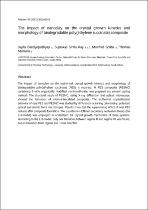 ResearchSpace
ResearchSpace
The impact of nanoclay on the crystal growth kinetics and morphology of biodegradable poly(ethylene succinate) composite
JavaScript is disabled for your browser. Some features of this site may not work without it.
- ResearchSpace
- →
- Research Publications/Outputs
- →
- Journal Articles
- →
- View Item
| dc.contributor.author |
Bandyopadhyay, J

|
|
| dc.contributor.author |
Ray, SS

|
|
| dc.contributor.author |
Scriba, Manfred R

|
|
| dc.contributor.author |
Malwela, T

|
|
| dc.date.accessioned | 2016-07-20T11:09:14Z | |
| dc.date.available | 2016-07-20T11:09:14Z | |
| dc.date.issued | 2012-07 | |
| dc.identifier.citation | Bandyopadhyay, J. Ray, S.S. Scriba, M. and Malwela, T. 2012. The impact of nanoclay on the crystal growth kinetics and morphology of biodegradable poly(ethylene succinate) composite. Polymer, 53(16), 3602-3612 | en_US |
| dc.identifier.issn | 0032-3861 | |
| dc.identifier.uri | http://www.sciencedirect.com/science/article/pii/S0032386112005034 | |
| dc.identifier.uri | http://hdl.handle.net/10204/8671 | |
| dc.description | Copyright: 2012 Elsevier. Due to copyright restrictions, the attached PDF file only contains the abstract of the full text item. For access to the full text item, please consult the publisher's website. The definitive version of the work is published in Polymer, 53(16), 3602-3612 | en_US |
| dc.description.abstract | The impact of nanoclay on the isothermal crystal growth kinetics and morphology of biodegradable poly(ethylene succinate) (PES) is reported. A PES composite (PESNC) containing 5 wt% organically modified montmorillonite, was prepared via solvent casting method. The structural study of PESNC, using X-ray diffraction and optical microscope, showed the formation of micro-intercalated composite. The isothermal crystallization behavior of neat PES and PESNC was studied by differential scanning calorimetry, polarized optical and atomic force microscopes. Results show that the supercooling effect of neat PES reduces after composite formation. The Lauritzene-Hoffman secondary nucleation theory (the LH-model) was employed to understand the crystal growth mechanism of these systems. According to the LH-model, only one transition between regime II and regime III was found, but no transition from regime I to II was detected. | en_US |
| dc.language.iso | en | en_US |
| dc.publisher | Elsevier | en_US |
| dc.relation.ispartofseries | Workflow;9470 | |
| dc.subject | Crystal growth kinetics | en_US |
| dc.subject | Crystal growth morphology | en_US |
| dc.subject | Nanoclay | en_US |
| dc.subject | Polymers | en_US |
| dc.title | The impact of nanoclay on the crystal growth kinetics and morphology of biodegradable poly(ethylene succinate) composite | en_US |
| dc.type | Article | en_US |
| dc.identifier.apacitation | Bandyopadhyay, J., Ray, S., Scriba, M. R., & Malwela, T. (2012). The impact of nanoclay on the crystal growth kinetics and morphology of biodegradable poly(ethylene succinate) composite. http://hdl.handle.net/10204/8671 | en_ZA |
| dc.identifier.chicagocitation | Bandyopadhyay, J, SS Ray, Manfred R Scriba, and T Malwela "The impact of nanoclay on the crystal growth kinetics and morphology of biodegradable poly(ethylene succinate) composite." (2012) http://hdl.handle.net/10204/8671 | en_ZA |
| dc.identifier.vancouvercitation | Bandyopadhyay J, Ray S, Scriba MR, Malwela T. The impact of nanoclay on the crystal growth kinetics and morphology of biodegradable poly(ethylene succinate) composite. 2012; http://hdl.handle.net/10204/8671. | en_ZA |
| dc.identifier.ris | TY - Article AU - Bandyopadhyay, J AU - Ray, SS AU - Scriba, Manfred R AU - Malwela, T AB - The impact of nanoclay on the isothermal crystal growth kinetics and morphology of biodegradable poly(ethylene succinate) (PES) is reported. A PES composite (PESNC) containing 5 wt% organically modified montmorillonite, was prepared via solvent casting method. The structural study of PESNC, using X-ray diffraction and optical microscope, showed the formation of micro-intercalated composite. The isothermal crystallization behavior of neat PES and PESNC was studied by differential scanning calorimetry, polarized optical and atomic force microscopes. Results show that the supercooling effect of neat PES reduces after composite formation. The Lauritzene-Hoffman secondary nucleation theory (the LH-model) was employed to understand the crystal growth mechanism of these systems. According to the LH-model, only one transition between regime II and regime III was found, but no transition from regime I to II was detected. DA - 2012-07 DB - ResearchSpace DP - CSIR KW - Crystal growth kinetics KW - Crystal growth morphology KW - Nanoclay KW - Polymers LK - https://researchspace.csir.co.za PY - 2012 SM - 0032-3861 T1 - The impact of nanoclay on the crystal growth kinetics and morphology of biodegradable poly(ethylene succinate) composite TI - The impact of nanoclay on the crystal growth kinetics and morphology of biodegradable poly(ethylene succinate) composite UR - http://hdl.handle.net/10204/8671 ER - | en_ZA |





